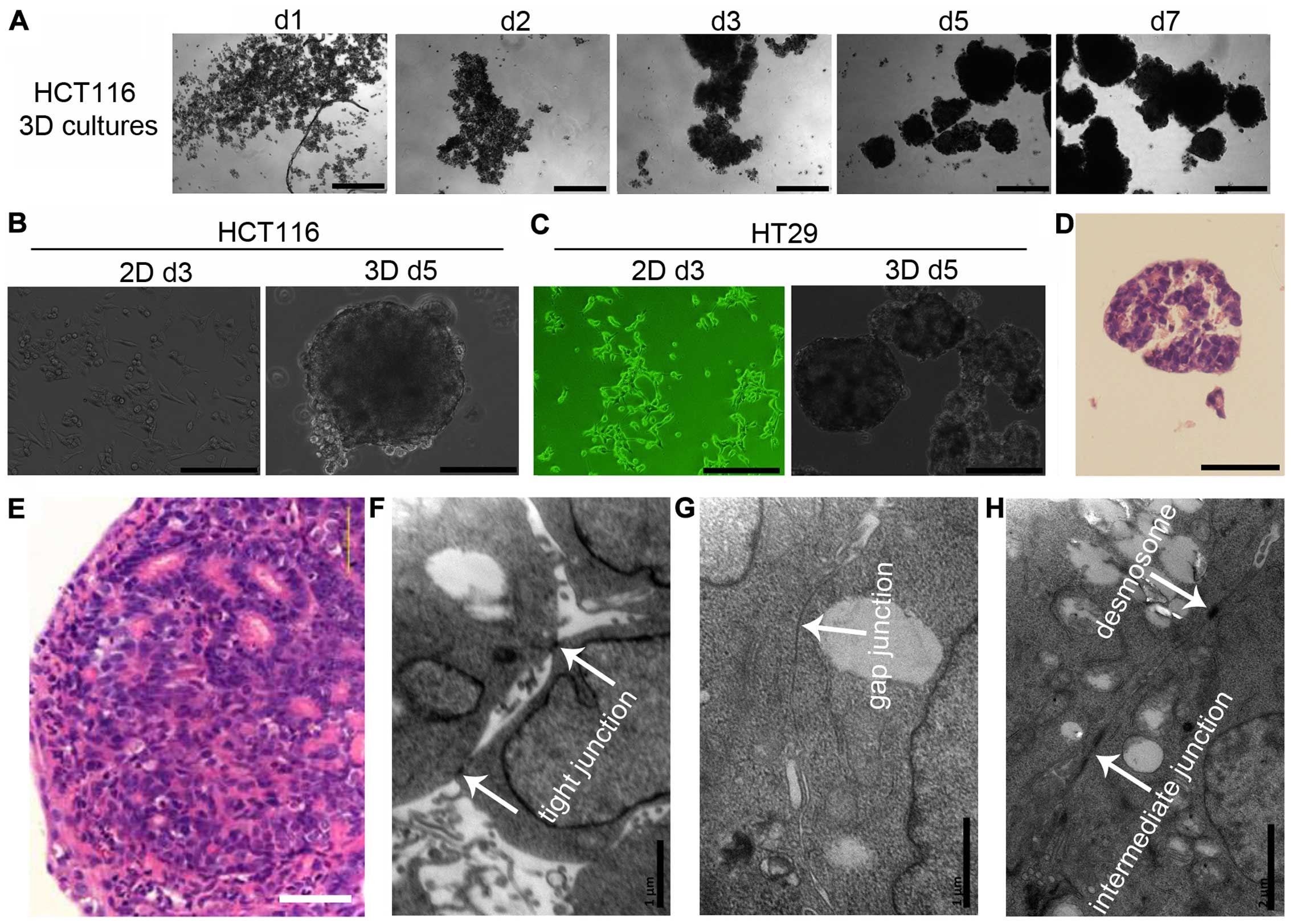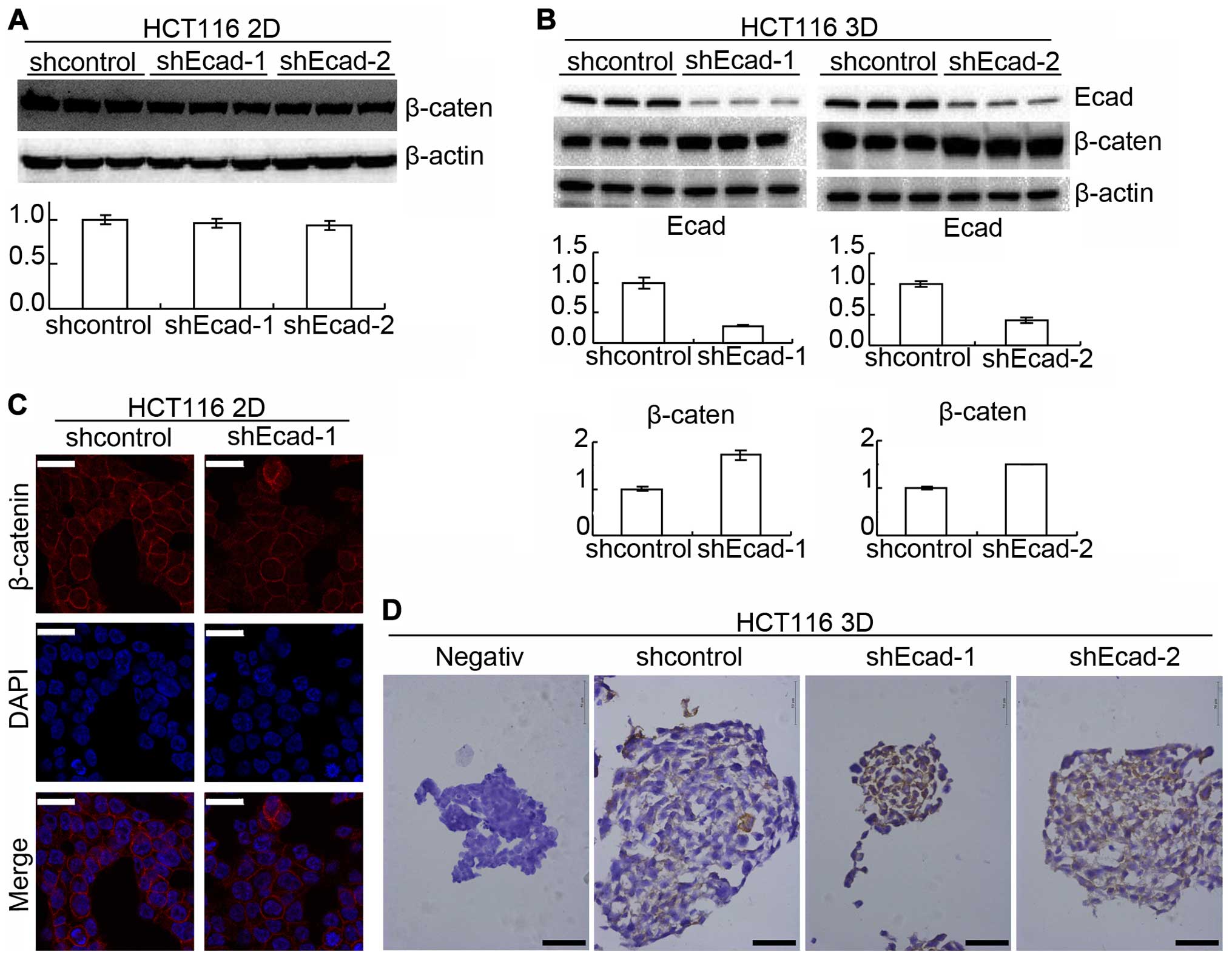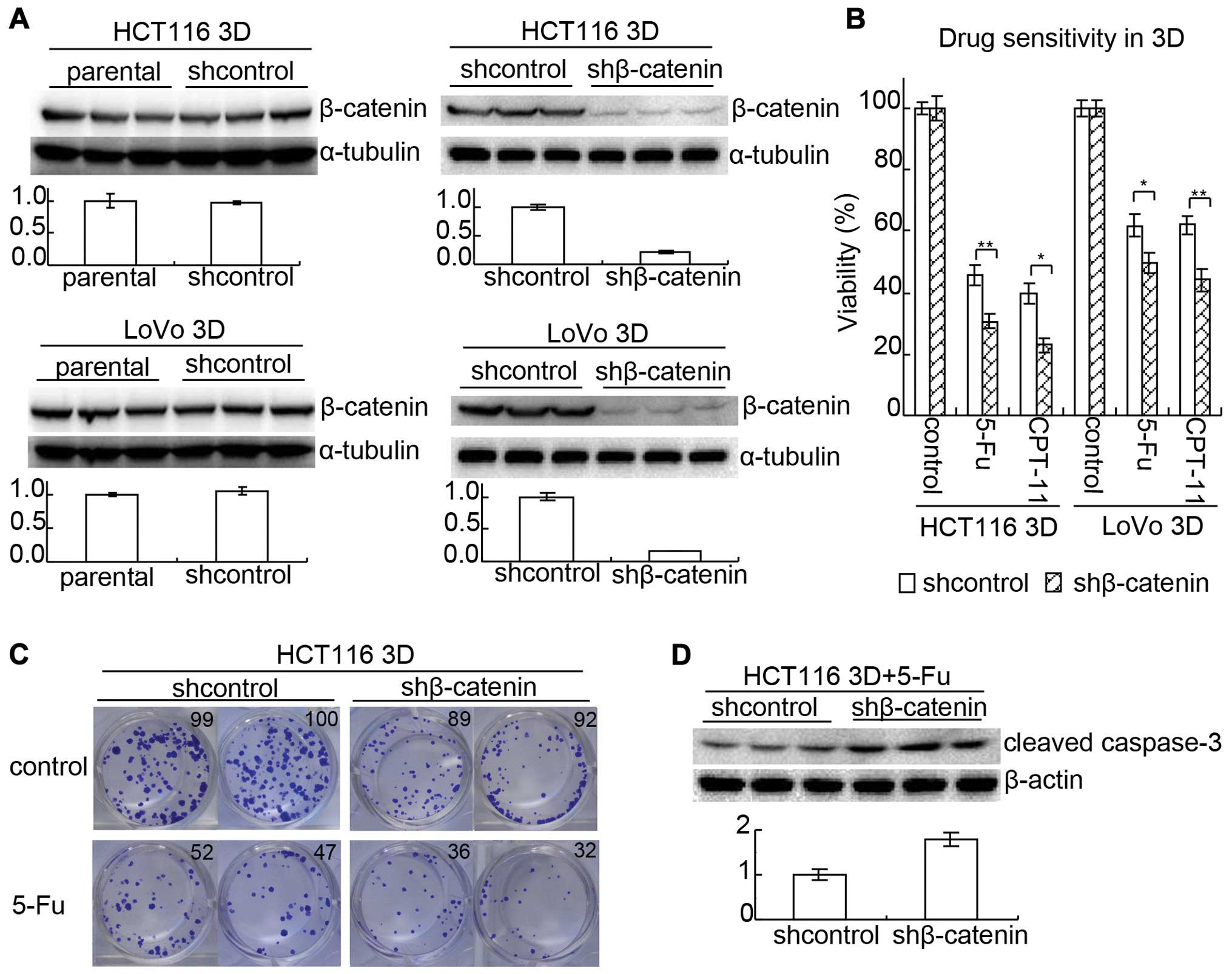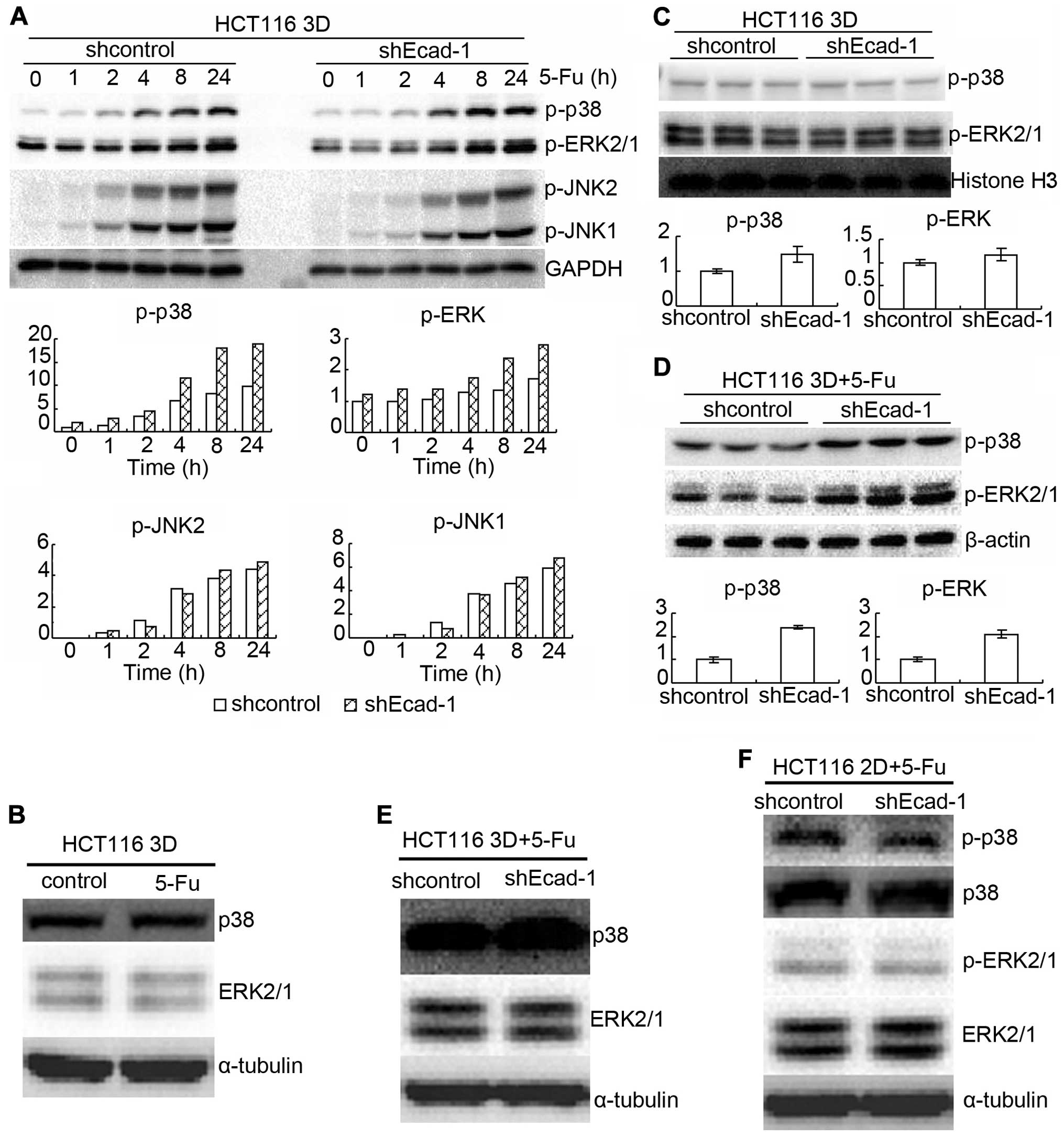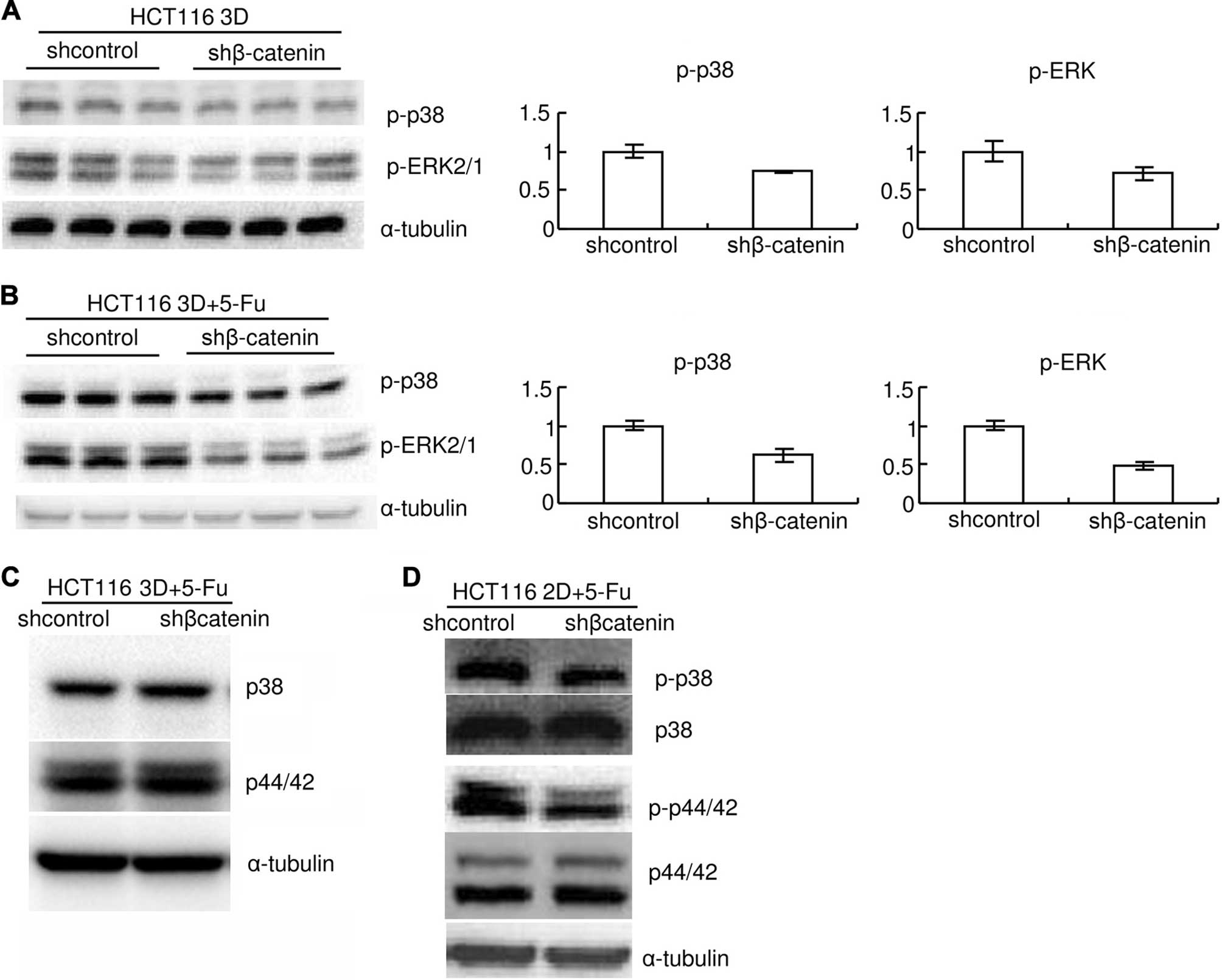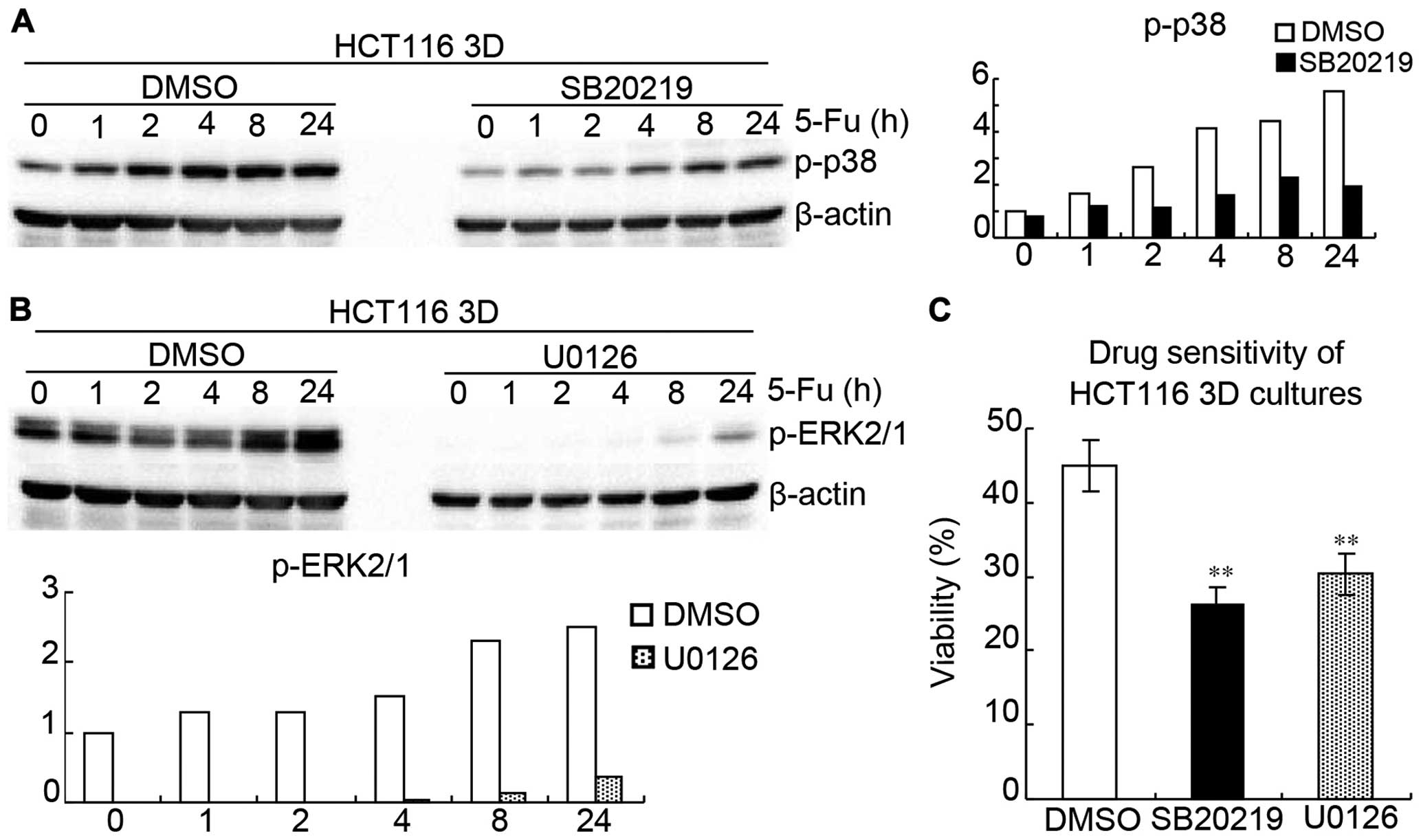E-cadherin knockdown increases β-catenin reducing colorectal cancer chemosensitivity only in three-dimensional cultures
- Authors:
- Published online on: August 27, 2015 https://doi.org/10.3892/ijo.2015.3137
- Pages: 1517-1527
Abstract
Introduction
Cells in vivo proliferate and survive under the influence of adjacent cells (1–3). Cell-cell adhesion is important for tumor cell biological behavior, including chemosensitivity (1,2,4–7). Intercellular adhesion is not well recapitulated in two-dimensional (2D) cell cultures and this may explain, in part, the phenomenon that novel anticancer drugs often offer only a small improvement over older agents or even fail to offer improvement in clinical trials, though they exhibit exciting anticancer effect in vitro (1–6). Three-dimensional (3D) cell culture models represent a better approximation of solid tumor tissue microenvironment, including cell adhesion and chemosensitivity in vivo than 2D cultures (1–8).
E-cadherin (Ecad), a classic member of the cadherin family, is responsible for cell-cell adhesion (2,9–13). On the other hand, intercellular force and E-cadherin binding to cadherins on adjacent cells trigger certain E-cadherin signaling cascades (9,10,12). Decreased expression of E-cadherin is strongly correlated with colorectal cancer, including prognosis (14,15). Therefore, we explored the role of E-cadherin in colorectal cancer chemosensitivity using 3D cultures. E-cadherin knockdown significantly reduced chemosensitivity via increasing β-catenin in 3D cultures while these effects were not observed in 2D cultures.
Materials and methods
Cell lines and cell culture
Human colorectal cancer cell lines, HCT116, HT29, LoVo and human embryonic kidney 293T were obtained from the Cell Bank, Chinese Academy of Science.
2D cultures were routinely grown and passaged as previously described (4,16). In brief, cells were grown in McCoy's 5A (Gibco, Grand Island, NY, USA) (HCT116 and HT29), F12K (Gibco) (LoVo) or DMEM (293T) (Gibco) supplemented with 100 ml/l fetal bovine serum (Gibco), 100,000 IU/l penicillin, and 100 mg/l streptomycin (Gibco) under a humidified atmosphere of 5% CO2 at 37°C.
3D cultures were prepared by using the liquid overlay technique as previously described (2,4,17). In brief, exponentially-growing cancer cells were seeded into plates what were previously coated with 2% agarose. Plates were gently horizontally swirled 10 min every 6 h for the first 24 h on an orbital shaker in order to form multicellular spheroids. Cells were incubated under a humidified atmosphere of 5% CO2 at 37°C. Appropriate medium was refreshed every day.
Lentiviral delivery of shRNA
E-cadherin and β-catenin were knocked down through the use of lentiviral vector-mediated shRNA interference using The RNAi Consortium System (Open Biosystems, Inc., Huntsville, AL, USA) according to the manual, respectively (18). Sense sequences of shRNAs targeting specific genes are AAGATAGGAGTTCTCTGATGC (shEcad-1) or ATACCAGAACCTCGAACTATA (shEcad-2) for E-cadherin (18) and GCTTGGAATGAGACTGCTGAT for β-catenin (shβ-catenin) (18). Control shRNA (shcontrol) is targeted against green fluorescent protein and the sense sequence of shRNA is TACAACAGCCACAACGTCTAT. E-cadherin/β-catenin-targeting shRNA-pLKO.1 vector or a control shRNA-pLKO.1 vector with the packaging plasmid pCMV-Dr8.91 and the enveloping plasmid pCMV-VSV-G were co-transfected into 293T cells with Lipofectamine® 2000 (Invitrogen, Carlsbad, CA, USA) according to the manual. Virus-containing media was collected at 48 and 72 h post-transfection, and was filtered. Cells were infected with lentivirus encoding shRNA targeted specific genes or control lentivirus, respectively. Then, cells were selected using puro-mycin (Sigma-Aldrich, St. Louis, MO, USA). Knockdown efficiency was confirmed by western blotting.
Hematoxylin and eosin (H&E) staining
HCT116 3D cultures were collected in a 1.5 ml Eppendorf tube. Following centrifugation (100 g, 2 min, 4°C), the supernatant was discarded. The pellet was fixed in 4% paraformaldehyde for 30 min. Following centrifugation (100 g, 3 min), the pellet was placed in 100% ethanol and xylene for 10 min at room temperature, and then in paraffin for 20 min at 65°C, respectively. The sample was embedded in paraffin and the paraffin-embedded sample was sectioned at a thickness of 10 μm. Sample slides were routinely stained with H&E.
Colorectal tumors were induced in C57BL/6 mice by azoxymethane (Sigma-Aldrich)-dextran sodium sulfate (MP Biomedicals, molecular weight 36,000–50,000 Da., Irvine, CA, USA) as previously described (19). Mice were sacrificed 20 weeks after azoxymethane treatment and colorectums were excised. Colorectal tumors were fixed in 10% formalin/PBS and paraffin-embedded samples were sectioned at a thickness of 6 μm. Sample slides were routinely stained with H&E. The study was approved by the Ethics Committee of Southwest Hospital.
Immunofluorescence staining
HCT116 cells were cultured as monolayer on cover slides for 72 h. After fixation in 4% paraformaldehyde for 30 min, cells were incubated in 0.2% Triton X-100 in 2% BSA/PBS for 30 min. Antibody of β-catenin (Cell Signaling Technology, Beverly, MA, USA) and Alexa Fluor 555 goat anti-rabbit (Invitrogen) were incubated for 2 h and 30 min, respectively. 4′,6-diamidino-2-phenylindole (DAPI) (1 μg/ml) (Sigma-Aldrich) was used for staining the nucleus of cells for 30 min.
Immunohistochemical staining
HCT116 3D cultures were fixed in 4% paraformaldehyde and OCT embedded samples were sectioned at a thickness of 10 μm. Immunohistochemistry was performed according to protocol of the SPlink Detection kits (ZSGB-Bio, Beijing, China) as previously described (16).
Preparation for transmission electron microscope slides
Sample slides were routinely prepared as previously described (4). In brief, 3D cultures were fixed in 2.5% glutaraldehyde, and then in 1% osmium tetroxide. Samples were dehydrated by graded alcohol, ultrathin sectioned. Sections were stained with uranium acetate and lead citrate, and observed using a transmission electron microscope (TECNAI10, Philip, The Netherlands).
Preparation of cell lysates
Cells were lysed in RIPA buffer (50 mM Tris base, 150 mM NaCl, 1% Nonidet P-40, 0.25% Na-deoxycholate, 1 mM EDTA) with protease inhibitors and phosphatase inhibitors (1 mM PMSF, 5 μg/ml leupeptin, 2 μg/ml pepstatin, 4 μg/ml aprotinin, 10 mM NaF, 1 mM Na3VO4, 10 mM β-glycerophosphate disodium salt pentahydrate) by incubating for 30 min on ice. Following centrifugation (26,000 × g, 16 min, 4°C), the supernatant was collected as total cell protein (19).
Western blot analysis
Protein was resolved by SDS/PAGE and blotted on nitrocellulose membranes (Bio-Rad, Richmond, CA, USA) as previously described (4,16,19). Nitrocellulose membranes were incubated with specific primary antibodies overnight. After incubating with secondary antibodies, immunoreactive proteins were visualized by the enhanced chemiluminescnet substrate (Thermo Scientific, Pittsburgh, PA, USA).
E-cadherin antibody was from Abcam Inc. (Cambridge, MA, USA). β-catenin antibody, phospho-mitogen-activated protein kinase (MAPK) Family Antibody Sampler kit, α-tubulin antibody, β-actin antibody, GAPDH antibody, histone H3, HRP-linked secondary antibody were from Cell Signaling Technology.
Clonogenic assay
Clonogenic assay in vitro were routinely performed as previously described (20). In brief, HCT116 3D cultures were collected in 2 ml medium. 0.2 ml medium containing 3D cultures was taken into a 0.5 ml Eppendorf tube. Following centrifugation (100 g, 5 min), the pellet was detached by accutase and the cells number of the single-cell suspension were assayed. Then, the cells number of the 3D cultures was calculated. The same amount of HCT116 3D cultures was treated with 80 mg/l 5-FU for 24 h. Then, 3D cultures were detached by accutase and the same ratio of single-cell suspensions were seeded into 24-well plates duplicate. Cells were cultured at 37°C for 7 days, then stained with crystal violet.
WST assay for sensitivity to anticancer drugs
Cytotoxic activity in 2D cultures was determined by tetrazolium salt-based proliferation assay (WST assay) using the cell counting kit-8 (Dojindo Laboratories, Kumamoto, Japan) according to the manual as previously described (4,21). In brief, HCT116 cells were cultured in 96-well plates as monolayer. Then, 10 μl of a graded concentration of 5-fluorouracil (5-FU) or irinotecan (CPT-11) were added into each well and cultured for 24 h. Control cultures received 10 μl PBS only. Each contained 8 independent samples. After 24 h, 10 μl of WST solution were added to each well and the plates were incubated for another 2 h. Absorbance was measured at 450 nm using a microplate reader with reference wavelength of 650 nm. Cell viability was measured and compared with that of control cells.
Cytotoxic activity in 3D cultures was determined by WST using the similar way to assay cytotoxic activity in 2D cultures as previously described (4,17,21). Before incubating with WST, 3D cultures were detached by accutase for 2 min. Cell viability was measured and compared with that of 3D cultures treated with PBS.
Statistical analyses
The data shown represent the mean ± standard error. Statistical differences between groups were analyzed by one-way ANOVA. p<0.05 was considered statistically significant.
Results
Cell-cell adhesion in 3D cultures
When seeded under non-adhesive conditions, dispersed cells (HCT116 and HT29) aggregated automatically and formed 3D cultures (multicellular spheroids) within 24 h. Cells adhered to each other loosely. Three days later, cells adhered tightly to other cells and 3D cultures could be hardly dispersed into single cells by pipetting (Fig. 1A–C).
To further analyze cell-cell adhesive systems, HCT116 3D cultures were stained with H&E. 3D cultures consisted of layers of cells and the cells were packed tightly (Fig. 1D). These structures mimic tumors at avascular stage or avascular tumor regions (Fig. 1E). HCT116 3D cultures were also observed using a transmission electron microscope. Cell-cell junctions, including tight junctions, gap junctions, intermediate junctions and desmosomes, were commonly found in 3D cultures. Cell-cell junctions were found in most of cells (Fig. 1F–H).
E-cadherin knockdown does not change the architecture formation of 3D cultures
E-cadherin is expressed by a variety of tissues and plays a key role in mediating cell-cell adhesive systems (9,10). It was reported that inhibition of E-cadherin function in cell-cell adhesion by E-cadherin neutralizing antibody (SHE78-7) disrupted preformed colorectal cancer cell 3D cultures (6,13). In this study, E-cadherin in HCT116 was knocked down by lentiviral delivery of shRNA. The efficiency was confirmed by western blotting (Fig. 2A). HCT116 with E-cadherin knockdown (shEcad) grew as multicellular spheroids as HCT116 transfected with control lentivirus for 16 days and no difference was observed under an invert microscope (Fig. 2B). LoVo cells were also employed because E-cadherin expression in LoVo was too low to be detected using western blotting (Fig. 2A). LoVo cells also automatically formed spheroids under 3D culture conditions (Fig. 2B). The above suggested that E-cadherin knockdown does not change the architecture formation of 3D cultures, as assessed under the inverted microscope.
E-cadherin knockdown in HCT116 reduces chemosensitivity only in 3D cultures
Intercellular force and homophilic binding of E-cadherin on adjacent cells trigger certain E-cadherin signaling cascades (9,10,12). Therefore, the function of E-cadherin in 3D cultures may be different from in 2D cultures. Thus, the role of E-cadherin in chemosensitivity in 3D cultures and in 2D cultures was explored.
WST assay was performed to evaluate sensitivity to anti-cancer drugs (Fig. 3A). The viability of parental HCT116 3D cultures treated with 80 mg/l 5-FU for 24 h was 45.7±3.1% and that of shcontrol was 47.9±3.3%. There was no significant difference (p≥0.05). Compare to the shcontrol, the viability of shEcad-1 HCT116 3D cultures treated with 80 mg/l 5-FU increased to 66.0±2.9% (p<0.01) and that of shEcad-2 increased to 61.8±2.5% (p<0.01). E-cadherin knockdown also decreased chemosensitivity to CPT-11. The viabilities of parental, shcontrol, shEcad-1 and shEcad-2 treated with 6 mg/l CPT-11 were 39.7±3.1, 34.0±3.7 (vs parental: p≥0.05), 50.6±2.0 (vs shcontrol: p<0.01) and 47.1±2.3% (vs shcontrol: p<0.01).
Results from the clonogenic assay were consistent with the WST assay. E-cadherin knockdown increased the clonogenicity (Fig. 3B). Cleaved caspase-3 of shcontrol HCT116 3D cultures and shEcad-1 HCT116 3D cultures treated with 20 mg/l 5-FU for 24 h was analyzed by western blotting. Result showed that E-cadherin knockdown decreased cleaved caspase-3 (Fig. 3C).
To explore the effect of E-cadherin knockdown on chemosensitivity in 2D cultures, sensitivity was performed by WST assay (Fig. 3D). The viability of parental, shcon-trol and shEcad-1 HCT116 cells, respectively, treated with 20 mg/l 5-FU was 35.0±2.3, 36.4±2.0 (vs parental: p≥0.05) and 37.9±2.9% (vs shcontrol: p≥0.05). The viability of parental, shcontrol and shEcad-1 treated with 80 mg/l 5-FU was 23.3±2.1, 21.3±2.1 (vs parental: p≥0.05) and 24.2±2.4% (vs shcontrol: p≥0.05). The viability, respectively, of parental, shcontrol and shEcad-1 treated with 2 mg/l CPT-11 was 40.0±1.8, 37.9±2.5 (vs parental: p≥0.05) and 41.5±3.2% (vs shcontrol: p≥0.05). The viabilities of parental, shcontrol and shEcad-1 treated with 6 mg/l CPT-11 were 24.5±2.7, 21.0±2.5 (vs parental: p≥0.05) and 27.2±3.1% (vs shcontrol: p≥0.05). Thus, E-cadherin knockdown does not significantly change chemosensitivity in HCT116 2D cultures.
E-cadherin knockdown increases β-catenin reducing chemosensitivity only in 3D cultures
Protein β-catenin was reported to interact with E-cadherin and was also involved in cell adhesion (10,22). Western blotting showed that E-cadherin knockdown increased β-catenin in 3D cultures but did not detectably increased β-catenin in 2D cultures (Fig. 4A and B). To confirm the result, β-catenin was assayed by immunofluorescence in 2D cultures and immunohistochemistry in 3D cultures. Immunofluorescence showed that β-catenin was not significantly changed by E-cadherin knockdown in 2D cultures (Fig. 4C) while immunohistochemistry showed that E-cadherin knockdown increased β-catenin in 3D cultures (Fig. 4D).
As mentioned above, E-cadherin knockdown increased β-catenin and decreased chemosensitivity only in 3D cultures. Since it was reported that enhancing β-catenin expression promoted anticancer drug resistance (23), β-catenin may be involved in the mechanism of E-cadherin knockdown decreasing chemosensitivity in 3D cultures. To confirm this, β-catenin in HCT116 and LoVo was knocked down by lenti-viral delivery of shRNA, respectively. After the efficiency was confirmed by western blotting (Fig. 5A), chemoensitivity to 5-FU and CPT-11 in 3D cultures was evaluated by WST assay (Fig. 5B). The viability of shcontrol HCT116 treated with 80 mg/l 5-FU was 45.7±3.1% while that of β-catenin knock-down (shβ-catenin) HCT116 was 30.8±2.1% (p<0.01). The viability of shcontrol HCT116 treated with 6 mg/l CPT-11 was 39.7±3.1% while that of shβ-catenin was 22.9±2.2% (p<0.05). Results in LoVo 3D cultures were similar to those in HCT116. The viability of shcontrol LoVo treated with 80 mg/l 5-FU was 61.9±3.4% while that of shβ-catenin was 49.6±3.3% (p<0.05). The viability of shcontrol LoVo treated with 6 mg/l CPT-11 was 62.1±3.0% while that of shβ-catenin was 44.2±3.7% (p<0.01).
Results from clonogenic assay were consistent with WST assay. Knockdown of β-catenin decreased the clonogenicity (Fig. 5C). It seemed that knockdown of β-catenin decreased both the size of clones and the clonogenicity without 5-FU treatment. The ratio of clonogenicity with 5-FU:clonogenicity without 5-FU was lower in the shβ-catenin group than in the shcontrol group. Cleaved caspase-3 of shcontrol HCT116 3D cultures and shβ-catenin HCT116 3D cultures treated with 20 mg/l 5-FU for 24 h was analyzed by western blotting. Result showed that knockdown of β-catenin increased cleaved caspase-3 (Fig. 5D).
The above suggests that E-cadherin knockdown increases β-catenin to reduce chemosensitivity in 3D cultures.
MAPK pathway is involved in mechanism of E-cadherin knockdown increasing β-catenin to reduce chemosensitivity
MAPK signaling plays a critical role in the sensitivity to anticancer therapies (4,24–28). Also, formation of E-cadherin-mediated cell-cell adhesion regulates MAPKs (29). Thus, the role of MAPKs in E-cadherin knockdown increasing β-catenin to reduce chemosensitivity was explored. HCT116 3D cultures were treated with 80 mg/l 5-FU for different time points. Protein p-p38, p-extracellular-signal-regulated kinase (ERK) 1/2 and p-c-Jun N-terminal kinase (JNK) 1/2 were assayed by western blotting. 5-FU treatment increased p-p38, p-ERK 1/2 and p-JNK 1/2 in a time dependent manner in HCT116 3D cultures (Fig. 6A). E-cadherin knockdown increased p-p38 and p-ERK 1/2, except JNK1/2 (Fig. 6A). Total p38 and ERK1/2 protein level was not detectably changed by 80 mg/l 5-FU treatment for 8 h (Fig. 6B). E-cadherin knockdown mildly increased basal levels of p-p38 and p-ERK1/2 (Fig. 6A and C). When treated with 80 mg/l 5-FU for 8 h, E-cadherin knockdown increased p-p38 and p-ERK1/2 in HCT116 3D cultures (Fig. 6A and D). E-cadherin knockdown neither changed total p38 and ERK1/2 protein level in 2D cultures nor in 3D cultures under treatment of 5-FU (Fig. 6E and F). E-cadherin knockdown did not detectably change p-p38 and p-ERK1/2 protein level in 2D cultures, either (Fig. 6F). Knockdown of β-catenin also mildly decreased basal levels of p-p38 and p-ERK1/2 (Fig. 7A). Knockdown of β-catenin decreased p-p38 and p-ERK1/2 induced by 80 mg/l 5-FU 8-h treatment both in 3D cultures and in 2D cultures (Fig. 7B and D). Total p38 or ERK1/2 protein level was not detectably changed by β-catenin knockdown (Fig. 7C and D). The results together with the above indicate that E-cadherin knockdown increases β-catenin only in 3D cultures but β-catenin enhances p-p38 and p-ERK1/2 both in 3D cultures and in 2D cultures.
SB202190 (p38 inhibitor) (30) and U0126 (ERK1/2 inhibitor) (31) were used to inhibit activations of p38 and ERK1/2 in HCT116 3D cultures, respectively. HCT116 3D cultures were treated with 20 μM SB202190, 20 μM U0126 or DMSO 1 h following treatment of 80 mg/l 5-FU for different time periods, respectively. Western blotting showed that SB202190 remarkably inhibited p-p38 and U0126 remarkably inhibited p-ERK1/2 (Fig. 8A and B). WST showed that inhibition of p38 or ERK1/2 activation significantly increased HCT116 3D cultures chemosensitivity to 5-FU, respectively (Fig. 8C). HCT116 3D cultures were treated with 20 μM SB202190, 20 μM U0126 or DMSO 1 h following treatment of 80 mg/l 5-FU for 24 h, respectively. The viabilities of DMSO, SB202190 and U0126 were 44.1±3.5, 26.6±2.3 (vs DMSO: p<0.01), and 30.0±2.6% (vs DMSO: p<0.01), thus suggesting that MAPK pathway is involved in E-cadherin knockdown increasing β-catenin to reduce chemosensitivity.
Discussion
Colorectal cancer is one of the most lethal diseases of all malignancies world-wide (32,33). The incidence of colorectal cancer in developing countries is increasing, partly attributing to lipid metabolism (19,32,33). More than 35% of the patients die within 5 years after diagnosis even in developed countries (32,33). This discouraging fact is largely due to the ability of a malignant tumor to demonstrate resistance to chemotherapies new, and old (4,5,25). Accumulating evidence indicates that microenvironment influences tumor cells biological behavior, including chemosensitivity (4,5). Among the myriad of microenvironmental factors impacting on cancer cell chemosensitivity, cell-cell adhesion has recently been identified as key determinant (1–2,4–6,25). In 3D cultures, cells adhered to each other within layers of cells. All types of cell-cell junctions, including tight junctions, gap junctions, intermediate junctions and desmosomes, were commonly found (Fig. 1). Their structures are very similar to tumors at avascular stage or avascular tumor regions (Fig. 1) (1,3,10,17), indicating 3D cultures have the potential to bridge the gap between monolayer cultures and xenografts for deciphering the function of cell-cell adhesive systems (1,3,10,17).
E-cadherin plays a key role in mediating cell-cell adhesive systems (2,6,9,10). It was reported that inhibition of E-cadherin function in cell-cell adhesion only by E-cadherin neutralizing antibody (SHE78-7) disrupted preformed 3D cultures (6,13). However, E-cadherin knockdown did not prevent suspension of HCT116 from 3D culture formation. E-cadherin protein in LoVo cells was too low to be detected using western blotting while LoVo cells formed 3D cultures (Fig. 2). It was also reported that prostate cancer cell line PC-3 with E-cadherin epigenetically silenced, could form 3D cultures (13,34). Therefore, E-cadherin may not be essential for architecture formation of 3D cultures in vitro as tumors in vivo.
Decreased E-cadherin expression correlates with poor prognosis in patients with colorectal cancer (15). Intercellular force and homophilic binding of cadherin on adjacent cells trigger E-cadherin to interact with certain proteins, for example β-catenin, to activate signaling cascades (9,10,12,22). Since 3D cultures better reflect cell-cell adhesion and chemosensitivity in vivo tumors (Fig. 1) (1,2,4–8,13,17) the role of E-cadherin in colorectal cancer chemosensitivity was explored in 3D cultures. E-cadherin knockdown significantly decreased chemosensitivity to anticancer drugs in 3D cultures but did not significantly change chemosensitivity in 2D cultures (Fig. 3).
Under chemotherapy, the molecular mechanisms deciding whether a tumor cell commits to cell death or survives are complex. β-catenin plays a critical role in survival and is involved in adhesion system (10,22,23) E-cadherin cytoplasmic domain contains a catenin-binding domain (10,22). E-cadherin knockdown increased β-catenin in 3D cultures and β-catenin knockdown significantly enhanced chemosensitivity (Figs. 3Figure 4–5). In 2D cultures, E-cadherin knockdown did not detectably change β-catenin (Fig. 4), suggesting E-cadherin knockdown increases β-catenin to decrease chemosensitivity only in 3D cultures.
Mounting evidence indicates a critical role of apoptotic pathways in determining the response of human cancers to anticancer drugs, including 5-FU (3,25,35,36). Caspase-3 plays a key role in apoptosis induced by 5-FU and cleaved caspase-3 is considered as an apoptotic marker (35). E-cadherin knockdown significantly decreased cleaved caspase-3 induced by 5-FU and β-catenin knockdown significantly increased cleaved caspase-3 (Figs. 3C and 5D). Thus, suggesting apoptosis is involved in the mechanism of E-cadherin knockdown increasing β-catenin to reduce chemosensitivity.
Among the many cell signaling transduction pathways regulating apoptosis, the MAPK signaling pathway plays an important role in the sensitivity to anticancer therapies (27,28,30,31,37) Also, formation of E-cadherin-mediated cell-cell adhesion regulates MAPKs (29). However, the role of MAPKs in cancer is as pleiotropic as cancer itself (27–31,38). In this study, p38, ERK1/2 and JNK1/2 were dramatically activated by chemotherapy (Fig. 6A and B). E-cadherin knockdown enhanced chemotherapy-induced p-p38 and p-ERK1/2, except p-JNK1/2 only in 3D cultures (Fig. 6). Knockdown of β-catenin attenuated chemotherapy-induced p-p38 and p-ERK1/2 both in 3D cultures and in 2D cultures (Fig. 7). Treatment of 3D cultures with SB202190 to inhibit p38 activation or U0126 to inhibit ERK1/2 activation significantly increased chemosensitivity, respectively (Fig. 7). The above suggests E-cadherin knockdown increases β-catenin to reduce chemosensitivity only in 3D cultures and β-catenin increasing p-p38/p-ERK1/2 is involved in the mechanism though the β-catenin-MAPK pathway is not unique in 3D cultures.
In conclusion, 3D cultures consist of layers of cells, preserving cell-cell adhesive systems. These allow a good model to decipher the function of cell-cell adhesive systems in cancer. Intercellular adhesion triggers certain E-cadherin signaling cascades (9,10,12). Data in this study indicate that E-cadherin knockdown significantly increases β-catenin resulting in decrease of chemosensitivity in 3D cultures but this effect was not detected in 2D cultures. β-catenin enhancing the p-p38/p-ERK1/2 is involved in this mechanism, though the β-catenin-MAPK pathway is not unique in 3D cultures.
Acknowledgements
This study was supported by the National Natural Science Foundation of China (grant no. 81000990), the Natural Science Foundation Project of CQ CSTC (grant no. 2009BB5339) and the Science Foundation of Third Military Medical University for the Young Scholar (grant no. 2009XQN32).
Abbreviations:
|
3D |
three-dimensional |
|
2D |
two-dimensional |
|
Ecad |
E-cadherin |
|
sh |
small hairpin |
|
H&E |
hematoxylin and eosin |
|
DAPI |
4′,6-diamidino-2-phenylindole |
|
MAPK |
mitogen-activated protein kinase |
|
WST assay |
tetrazolium salt-based proliferation assay |
|
5-FU |
5-fluorouracil |
|
CPT-11 |
irinotecan |
|
ERK |
extracellular-signal-regulated kinase |
|
JNK |
c-Jun N-terminal kinase |
|
shEcad |
knockdown E-cadherin by shRNA |
|
shβ-catenin |
knockdown β-catenin by shRNA |
|
shcontrol |
control shRNA targeted against green fluorescent protein |
|
d |
day |
|
h |
hour |
References
|
Shamir ER and Ewald AJ: Three-dimensional organotypic culture: Experimental models of mammalian biology and disease. Nat Rev Mol Cell Biol. 15:647–664. 2014. View Article : Google Scholar : PubMed/NCBI | |
|
Kang HG, Jenabi JM, Zhang J, Keshelava N, Shimada H, May WA, Ng T, Reynolds CP, Triche TJ and Sorensen PH: E-cadherin cell-cell adhesion in ewing tumor cells mediates suppression of anoikis through activation of the ErbB4 tyrosine kinase. Cancer Res. 67:3094–3105. 2007. View Article : Google Scholar : PubMed/NCBI | |
|
Desoize B and Jardillier J: Multicellular resistance: A paradigm for clinical resistance? Crit Rev Oncol Hematol. 36:193–207. 2000. View Article : Google Scholar : PubMed/NCBI | |
|
He JM, Wang FC, Qi HB, Li Y and Liang HJ: Down-regulation of alphav integrin by retroviral delivery of small interfering RNA reduces multicellular resistance of HT29. Cancer Lett. 284:182–188. 2009. View Article : Google Scholar : PubMed/NCBI | |
|
Kobayashi H, Man S, Graham CH, Kapitain SJ, Teicher BA and Kerbel RS: Acquired multicellular-mediated resistance to alkylating agents in cancer. Proc Natl Acad Sci USA. 90:3294–3298. 1993. View Article : Google Scholar : PubMed/NCBI | |
|
Green SK, Karlsson MC, Ravetch JV and Kerbel RS: Disruption of cell-cell adhesion enhances antibody-dependent cellular cytotoxicity: Implications for antibody-based therapeutics of cancer. Cancer Res. 62:6891–6900. 2002.PubMed/NCBI | |
|
Yang Z and Zhao X: A 3D model of ovarian cancer cell lines on peptide nanofiber scaffold to explore the cell-scaffold interaction and chemotherapeutic resistance of anticancer drugs. Int J Nanomedicine. 6:303–310. 2011. View Article : Google Scholar : PubMed/NCBI | |
|
Lee JM, Mhawech-Fauceglia P, Lee N, Parsanian LC, Lin YG, Gayther SA and Lawrenson K: A three-dimensional microenvironment alters protein expression and chemosensitivity of epithelial ovarian cancer cells in vitro. Lab Invest. 93:528–542. 2013. View Article : Google Scholar : PubMed/NCBI | |
|
Engl W, Arasi B, Yap LL, Thiery JP and Viasnoff V: Actin dynamics modulate mechanosensitive immobilization of E-cadherin at adherens junctions. Nat Cell Biol. 16:587–594. 2014. View Article : Google Scholar : PubMed/NCBI | |
|
Gall TM and Frampton AE: Gene of the month: E-cadherin (CDH1). J Clin Pathol. 66:928–932. 2013. View Article : Google Scholar : PubMed/NCBI | |
|
Mattias L, Haque A, Adnan N and Akaike T: The effects of artificial E-cadherin matrix-induced embryonic stem cell scattering on paxillin and RhoA activation via α-catenin. Biomaterials. 35:1797–1806. 2014. View Article : Google Scholar | |
|
Truffi M, Dubreuil V, Liang X, Vacaresse N, Nigon F, Han SP, Yap AS, Gomez GA and Sap J: RPTPα controls epithelial adherens junctions, linking E-cadherin engagement to c-Src-mediated phosphorylation of cortactin. J Cell Sci. 127:2420–2432. 2014. View Article : Google Scholar : PubMed/NCBI | |
|
Nakamura T, Kato Y, Fuji H, Horiuchi T, Chiba Y and Tanaka K: E-cadherin-dependent intercellular adhesion enhances chemoresistance. Int J Mol Med. 12:693–700. 2003.PubMed/NCBI | |
|
Govatati S, Singamsetty GK, Nallabelli N, et al: Contribution of cyclin D1 (CCND1) and E-cadherin (CDH1) alterations to colorectal cancer susceptibility: A case-control study. Tumour Biol. 35:12059–12067. 2014. View Article : Google Scholar : PubMed/NCBI | |
|
Yun JA, Kim SH, Hong HK, Yun SH, Kim HC, Chun HK, Cho YB and Lee WY: Loss of E-Cadherin expression is associated with a poor prognosis in stage III colorectal cancer. Oncology. 86:318–328. 2014. View Article : Google Scholar : PubMed/NCBI | |
|
Li Y, He J, Zhong D, Li J and Liang H: High-mobility group box 1 protein activating nuclear factor-κB to upregulate vascular endothelial growth factor C is involved in lymphangiogenesis and lymphatic node metastasis in colon cancer. J Int Med Res. 43:494–505. 2015. View Article : Google Scholar : PubMed/NCBI | |
|
Phung YT, Barbone D, Broaddus VC and Ho M: Rapid generation of in vitro multicellular spheroids for the study of monoclonal antibody therapy. J Cancer. 2:507–514. 2011. View Article : Google Scholar : PubMed/NCBI | |
|
Onder TT, Gupta PB, Mani SA, Yang J, Lander ES and Weinberg RA: Loss of E-cadherin promotes metastasis via multiple downstream transcriptional pathways. Cancer Res. 68:3645–3654. 2008. View Article : Google Scholar : PubMed/NCBI | |
|
He J, Shin H, Wei X, Kadegowda AK, Chen R and Xie SK: NPC1L1 knockout protects against colitis-associated tumorigenesis in mice. BMC Cancer. 15:1892015. View Article : Google Scholar : PubMed/NCBI | |
|
Franken NA, Rodermond HM, Stap J, Haveman J and van Bree C: Clonogenic assay of cells in vitro. Nat Protoc. 1:2315–2319. 2006. View Article : Google Scholar | |
|
Tanaka E, Hashimoto Y, Ito T, Kondo K, Higashiyama M, Tsunoda S, Ortiz C, Sakai Y, Inazawa J and Shimada Y: The suppression of aurora-A/STK15/BTAK expression enhances chemosensitivity to docetaxel in human esophageal squamous cell carcinoma. Clin Cancer Res. 13:1331–1340. 2007. View Article : Google Scholar : PubMed/NCBI | |
|
Lee DJ, Kang DH, Choi M, et al: Peroxiredoxin-2 represses melanoma metastasis by increasing E-cadherin/β-catenin complexes in adherens junctions. Cancer Res. 73:4744–4757. 2013. View Article : Google Scholar : PubMed/NCBI | |
|
Liu Y, Ye X, Zhang JB, et al: PROX1 promotes hepatocellular carcinoma proliferation and sorafenib resistance by enhancing β-catenin expression and nuclear translocation. Oncogene. Feb 16–2015.(Epub ahead of print). View Article : Google Scholar | |
|
Koti M, Gooding RJ, Nuin P, Haslehurst A, Crane C, Weberpals J, Childs T, Bryson P, Dharsee M, Evans K, et al: Identification of the IGF1/PI3K/NF κB/ERK gene signalling networks associated with chemotherapy resistance and treatment response in high-grade serous epithelial ovarian cancer. BMC Cancer. 13:5492013. View Article : Google Scholar | |
|
Liu S, Wang J, Niu W, Liu E, Wang J, Peng C, Lin P, Wang B, Khan AQ, Gao H, et al: The β6-integrin-ERK/MAP kinase pathway contributes to chemo resistance in colon cancer. Cancer Lett. 328:325–334. 2013. View Article : Google Scholar | |
|
Basile KJ, Abel EV, Dadpey N, Hartsough EJ, Fortina P and Aplin AE: In vivo MAPK reporting reveals the heterogeneity in tumoral selection of resistance to RAF inhibitors. Cancer Res. 73:7101–7110. 2013. View Article : Google Scholar : PubMed/NCBI | |
|
Sui X, Kong N, Ye L, Han W, Zhou J, Zhang Q, He C and Pan H: p38 and JNK MAPK pathways control the balance of apoptosis and autophagy in response to chemotherapeutic agents. Cancer Lett. 344:174–179. 2014. View Article : Google Scholar | |
|
Pritchard AL and Hayward NK: Molecular pathways: Mitogen-activated protein kinase pathway mutations and drug resistance. Clin Cancer Res. 19:2301–2309. 2013. View Article : Google Scholar : PubMed/NCBI | |
|
Reddy P, Liu L, Ren C, Lindgren P, Boman K, Shen Y, Lundin E, Ottander U, Rytinki M and Liu K: Formation of E-cadherin-mediated cell-cell adhesion activates AKT and mitogen activated protein kinase via phosphatidylinositol 3 kinase and ligand-independent activation of epidermal growth factor receptor in ovarian cancer cells. Mol Endocrinol. 19:2564–2578. 2005. View Article : Google Scholar : PubMed/NCBI | |
|
Tsai MS, Weng SH, Chen HJ, Chiu YF, Huang YC, Tseng SC, Kuo YH and Lin YW: Inhibition of p38 MAPK-dependent excision repair cross-complementing 1 expression decreases the DNA repair capacity to sensitize lung cancer cells to etoposide. Mol Cancer Ther. 11:561–571. 2012. View Article : Google Scholar | |
|
Csibi A, Fendt SM, Li C, Poulogiannis G, Choo AY, Chapski DJ, Jeong SM, Dempsey JM, Parkhitko A, Morrison T, et al: The mTORC1 pathway stimulates glutamine metabolism and cell proliferation by repressing SIRT4. Cell. 153:840–854. 2013. View Article : Google Scholar : PubMed/NCBI | |
|
Siegel R, Naishadham D and Jemal A: Cancer statistics, 2013. CA Cancer J Clin. 63:11–30. 2013. View Article : Google Scholar : PubMed/NCBI | |
|
Center MM, Jemal A, Smith RA and Ward E: Worldwide variations in colorectal cancer. CA Cancer J Clin. 59:366–378. 2009. View Article : Google Scholar : PubMed/NCBI | |
|
Härmä V, Knuuttila M, Virtanen J, Mirtti T, Kohonen P, Kovanen P, Happonen A, Kaewphan S, Ahonen I, Kallioniemi O, et al: Lysophosphatidic acid and sphingosine-1-phosphate promote morphogenesis and block invasion of prostate cancer cells in three-dimensional organotypic models. Oncogene. 31:2075–2089. 2012. View Article : Google Scholar : | |
|
Wu XX, Kakehi Y, Mizutani Y, Lu J, Terachi T and Ogawa O: Activation of caspase-3 in renal cell carcinoma cells by anthracyclines or 5-fluorouracil. Int J Oncol. 19:19–24. 2001.PubMed/NCBI | |
|
Samuel T, Fadlalla K, Gales DN, Putcha BD and Manne U: Variable NF-κB pathway responses in colon cancer cells treated with chemotherapeutic drugs. BMC Cancer. 14:5992014. View Article : Google Scholar | |
|
Shi X, Wu S, Yang Y, Tang L, Wang Y, Dong J, Lü B, Jiang G and Zhao W: AQP5 silencing suppresses p38 MAPK signaling and improves drug resistance in colon cancer cells. Tumour Biol. 35:7035–7045. 2014. View Article : Google Scholar : PubMed/NCBI | |
|
Jeong S, Jing K, Kim N, Shin S, Kim S, Song KS, Heo JY, Park JH, Seo KS, Han J, et al: Docosahexaenoic acid-induced apoptosis is mediated by activation of mitogen-activated protein kinases in human cancer cells. BMC Cancer. 14:4812014. View Article : Google Scholar : PubMed/NCBI |



